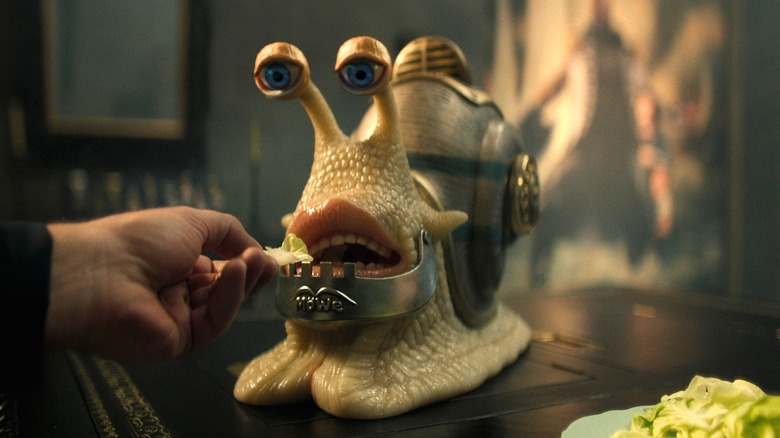One Piece: Why Are Giant Snails Used As Phones? Transponder Snails Explained
Contains minor spoilers for the "One Piece" manga and anime
When Netflix said it was bringing "One Piece" to life, the streamer wasn't joking. Even the strangest bits of Eiichiro Oda's manga have made the transition to live-action, and of them, the Transponder Snails have to be the weirdest. Introduced at the end of Episode 1, "Romance Dawn," we see Vice Admiral Garp (Vincent Regan) use an incredibly creepy-looking snail as if it were a telephone — nothing new to fans of the anime and manga, but newcomers may be wondering, how, exactly, do the Transponder Snails work?
Transponder Snails, or Den Den Mushi, are used throughout the "One Piece" world for vocal and visual communication. In a reality without advanced technology, the larger-than-normal animals' telepathic abilities allow them to use electronic signals to communicate with one another. They can also perfectly replicate anyone's voice, matching their inflections and cadences as if the words were coming straight from the source. While the exact details of how they're capable of doing these things is shrouded in mystery, the addition of dials and receivers allows people to use them as long-range communication devices.
Using dials, one can enter a specific number into a Transponder Snail, which telepathically links to the corresponding snail, mimicking real-world telephones. Some have even greater fax-machine-like abilities, including copying and sending documents, with ranges that can cross entire oceans. Thankfully, this relationship is mutually beneficial; Transponder Snails have no problems serving as a communication tool as long as they are well fed.
They come in many shapes and sizes
At this point, Netflix's "One Piece" only dives into the traditional communications device, though future seasons could bring the variant versions to live action. In both the "One Piece" manga and anime, there are multiple types of Transponder Snails, each with their own unique abilities. Within the audio-based variants are baby versions, which offer a more compact and portable means of communication, but their smaller size means a weaker signal. Marines also use Black Den Den Mushi to establish wiretaps and eavesdrop on other Transponder Snails' calls. To combat those, a rare breed of White Den Den Mushi nullifies the eavesdropping ability, effectively securing lines for confidential conversations. Similarly, the Horned Transponder Snail jams signals, disrupting communications between all nearby snails.
On the visual side, variants like Cameko act like cameras, taking pictures, storing images, and transmitting them to the Proko, which can then project the visuals on a larger display. Other variants, like the Projector and Surveillance Snails, serve similar functions, providing different visual aids depending on the scenario.
While the vast majority of Transponder Snails provide forms of communication, "One Piece" also involves two special variants that don't. The incredibly rare Golden Transponder Snail features a small button atop its shell, which, when pressed, calls in the full might of the World Government: the Buster Call. The other breed, the Silver Snail, receives the call from its golden counterpart, setting off a loud alarm. While we don't see them in the live-action series' first season, these Transponder Snails play a significant role in the Water 7 Saga, including Nico Robin's backstory.

